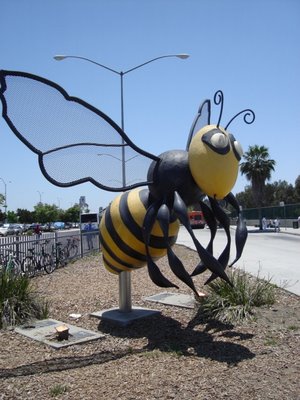
I had never heard of Norwalk until I decided to file a small claims suit. That's a separate story--about my car and a car wash. Yes, I do have a car. It's a 1993 Geo Prizm , and I use it for trips beyond L.A. county. While you can get anywhere fairly easily within the county, our regional system stinks. Again, I have to do the sad comparison to the East Coast. On the DC to Boston corridor the trains run frequently and on time. In California, expect a delay of an hour.
Norwalk's major attraction is the County Recorder's office. Hopeful entrepreneurs travel from across the county to register their businesses. Couples enter the matrimonial bureaucracy. And future performers on Judge Judy do research for their cases.
I take the orange line to the red line to the blue line to the green line--every color except the yellow. At the green line station there is a big bee sculpture by Meg Cranston, a reference to the Shoshonean name for the area as well as the contemporary "industrious" commuters.
According to the artist:
"For this project I wanted to convey a sense of history but also to reflect modern times. I chose bees as an emblem for Norwalk because they are linked with the area's earliest population. Like many of the commuters who use the station on their way to work, worker bees are industrious, peaceful, productive, and contribute to our survival (through cross-pollination). Bees also have exemplary social instincts—bee colonies are much like families.
As an artist I am interested in craftsmanship and I wanted to maintain the sense of a homemade object. I tried to give the bees a joyful attitude—to make them bright and fun. Something that would provide a smile to people both going to work and coming home.”
(Quoted at L.A. MTA Art Site.)
The danger of this careless mixing of "history" and "modern times" should be evident. First, the absurd desire to "bring a smile to the worker bee" mimics hopeless attempts to pacify the already weary urban fighter. Second, celebrating the "industrious" insect not only falls blindly into the criminal hierarchical logic of modern business theory, which many years ago Donna Haraway brilliantly linked to sociobiology, it also makes no sense in a post-fordist economy where the struggle to find and maintain a job is more important than the struggle on the job.
A more obvious problem: where are the honey bees? Isn't this the very definition of Simulacrum? The copy has replaced the real. The relationship of the native Shoshonean to the honey bee evokes a romantic vision of sustainability. In contemporary L.A., the buzz of an actual bee evokes a fear of getting stung. I've seen two hundred pound men run like preschoolers at the sight of a couple bees hovering around a squashed soda cup.
This is why the struggle to save the farm in south L.A. is so important. This farm provides just a tiny reminder that, despite our ruthless attempts to hide it, we are connected to the earth.
Corn syrup is bad for the world.

1 comment:
Sounds like you were intimidated by the bee.
Post a Comment